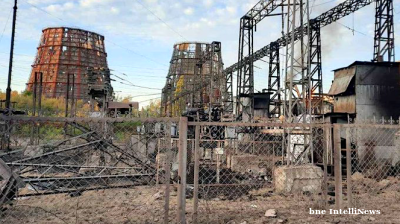Russian oil deliveries to Hungary off again after third attack on Druzhba pipeline as Ukraine ups attacks on Russian oil assets

Russian crude deliveries to Slovakia and Hungary were suspended on August 21 after a third attack on the Druzhba pipeline system in less than two weeks, officials confirmed. Flows are expected to remain offline for at least five days. The attack comes after similar attacks on August 13 and August 18.
Ukraine has been upping its attacks on Russian oil assets across the country in the last month, hoping to achieve what sanctions have failed to do – sheer Russia of its ability to make money to pay for its war machine. There have been eight attacks on Russian oil refineries in August alone and they are becoming more effective.
Hungary and Slovakia have found themselves in the frontline as major purchasers of Russian piped oil. Bratislava and Budapest appealed to the European Commission for urgent measures to safeguard their energy security, highlighting their reliance on Russian crude. In an open letter to European Commission Vice-President Kaja Kallas, the foreign ministers of both countries called for protection of critical infrastructure.
“The Druzhba pipeline is indispensable for our energy supply. Without it, providing oil to our countries is physically impossible,” said Hungary’s Minister of Foreign Affairs, Peter Szijjarto, in a statement posted on X.
The latest outage followed what regional governor Alexander Bogomaz described as a “massive attack” in Russia’s Bryansk region, where a fire broke out at an energy facility in the Unecha district. Previous attacks on Unecha’s pumping station disrupted crude flows to Hungary and Slovakia between August 13 and 18, forcing officials in both capitals to issue warnings over fuel supply risks.
Szijjarto labelled the new strike an “unacceptable assault” on Hungary’s energy security. He had previously estimated repairs from the August 13 incident would take one day, but a second attack on August 18 delayed recovery. He also warned Kyiv that Hungary supplies electricity to Ukraine and suggested this dependency should be considered.
Hungarian energy company MOL, the sole refiner operating in Hungary and Slovakia, depends on Russian crude for most of the 290,000 b/d processed at its Danube and Bratislava facilities. While efforts are underway to adapt both plants to alternative supplies, MOL has acknowledged that its Adria pipeline link from Croatia cannot fully replace Druzhba flows before 2026.
In a February 2025 deal, MOL and Croatian operator Janaf agreed on deliveries of 2.1mn tonnes of crude—equivalent to 42,000 b/d—via the Adria route, covering just 15% of the two refineries’ combined capacity. A MOL official told Platts last year that the pipeline could theoretically meet up to 80% of demand but warned operations would be unstable beyond short periods.
Russian oil assets in the cross hairs
The latest disruption follows a string of outages, including a Ukrainian crackdown on Lukoil flows in June 2024, a “technical incident” at Unecha in December, and a drone strike in March. Those interruptions spurred the Czech Republic to accelerate its shift away from Russian oil, after state reserves were tapped to keep Orlen Unipetrol’s refineries running.
This year Ukraine has escalated its attacks on Russian refineries and energy infrastructure as it takes it fight into Russia using increasingly powerful and long-range drones and missiles. The damage caused has increased and has sparked a fuel crisis with domestic supplies of petrol running out.
Ukraine carried out attacks on eight energy facilities in August, including a major strike on Russia’s Ryazan refinery that shut down about half its processing capacity, Forbes reports. The attacks have now effected about a third of Russia’s refining capacity.
Over the weekend, several drones launched by Ukraine struck the gas and oil export terminal at the Port of Ust-Luga in the Leningrad Oblast of Northwestern Russia, near the border Estonia and on the Gulf of Finland. Several fires can be seen burning at the port, with the smoke reportedly being seen as far as the outskirts of Saint Petersburg. The port is Russia’s major export facility for oil on its west coast.
And fires continued to burn and spread for a third day at the Novoshakhtinsk Oil Refinery in the Rostov Oblast of Southwestern Russia, after it was targeted earlier last week in a drone attack by the Armed Forces of Ukraine.
The Novoshakhtinsk Oil Refinery has been repeatedly attacked by the Armed Forces of Ukraine (AFU) since the full-scale invasion began. The first major attack came on June 22, 2022, when two drones struck the refinery and set off a large fire. A second reported attack occurred in December 2022, followed by another strike in March 2023 and a further incident in June 2023. Taken together, the facility has been hit successfully at least four to five times.
An August 2 attack on the Ryazan complex, which accounts for 5% of Russia’s refining capacity with an annual throughput of 13.1mn tonnes, marked one of Kyiv’s most damaging strikes of the summer. The escalation came despite a bilateral understanding between Russia and Ukraine, announced on March 25, to halt mutual energy infrastructure attacks. After the US suspended military aid after US President Donald Trump took office, Russia has resumed its bombardment of Ukraine’s energy infrastructure that saw most of its non-nuclear power generating capacity destoyed last year.
“Nothing resumed because nothing stopped,” Ukraine’s military intelligence said, according to Tymofiy Mylovanov, rector of the Kyiv School of Economics (KSE) and former economics minister in a social media post.
The timing of Ukraine’s escalation has coincided with Russia’s seasonal peak in fuel demand. Prices for 95-octane petrol rose 6.5% to a record RUB82,000 ($924) per tonne. Moscow is preparing to raise crude exports by 20% to offset reduced domestic refining, Reuters reported.
According to Mylovanov, repeated attacks on refineries and transport infrastructure were a key factor in Russian fuel production falling to a 12-year low of 267mn tonnes in 2024 and the outlook for this year is even worse.
News

Top US military officer for Latin America quits amid Venezuela tensions
The head of the Pentagon's Southern Command is to step down at the end of the year amid mounting tensions over the Trump administration's military operations in the Caribbean targeting alleged Venezuelan drug traffickers

Iran's Khamenei calls Trump a 'real terrorist'
Iran's Supreme Leader Khamenei tells Trump "what business is it of yours" regarding nuclear industry, calling US president's positions lies and bullying whilst rejecting claims of supporting Iranian people.
-fotor-bg-remover-20251020114620.png)
Bolivia elects centrist Rodrigo Paz to lead a nation in chaos
Bolivia has entered a new political era after Rodrigo Paz secured the presidency with 54.5% of the vote, defeating former conservative leader Jorge “Tuto” Quiroga.
_seen_here_meeting_with_Congressman_Jimmy_Panetta_201025_Cropped_1760946356.jpg)
Kazakhstan renews push for lifting of Jackson-Vanik trade restrictions
Visiting Astana official hopes for “speedy resolution.”


